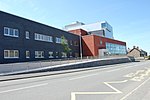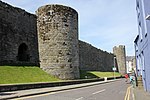Caernarfon Mithraeum
The Caernarfon Mithraeum is a Mithraic temple or Mithraeum. It was located 137 meters north-east of the Roman castram of Segontium on the outskirts of modern Caernarfon in Gwynedd, Wales. The remains were discovered by accident on 2 April 1958 and excavated by the National Museum of Wales in August of the following year under the direction of George Boon. The site was found to be already damaged by a sewer trench which cut across the anteroom and had removed part of the southeast corner, but the majority of the temple could be excavated. The excavators noted the site was quite marshy and this suggested that a stream had once flowed close to the temple at the bottom of the shallow valley. The marshy conditions caused the mechanical excavator to frequently fall into the excavation, causing further damage.
Excerpt from the Wikipedia article Caernarfon Mithraeum (License: CC BY-SA 3.0, Authors).Caernarfon Mithraeum
Lon Arfon,
Geographical coordinates (GPS) Address Nearby Places Show on map
Geographical coordinates (GPS)
| Latitude | Longitude |
|---|---|
| N 53.137172 ° | E -4.262414 ° |
Address
Lon Arfon
Lon Arfon
LL55 2ER , Caernarfon
Wales, United Kingdom
Open on Google Maps







